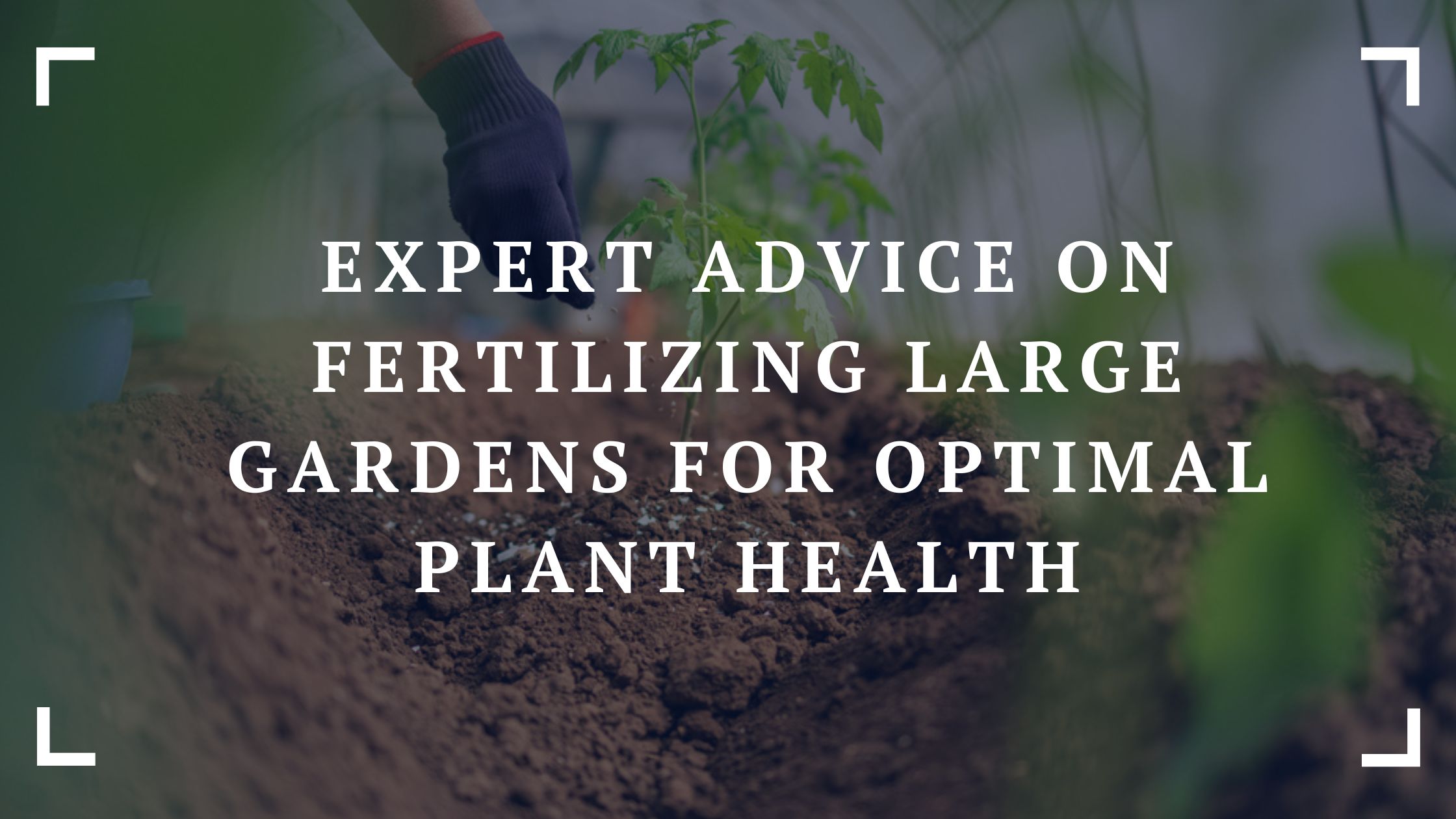A large garden can be a source of pride and joy for any gardener, but it also comes with its unique set of challenges. One of the most critical aspects of maintaining a healthy and thriving garden is proper fertilization. Fertilizing a large garden can be a daunting task, but with the right knowledge and techniques, you can ensure your plants receive the nutrients they need to flourish. In this article, we will explore expert advice on fertilizing large gardens to achieve optimal plant health and create a stunning outdoor space.

1. Understand the Basics of Plant Nutrition
Before diving into the world of fertilizers, it’s essential to understand the basics of plant nutrition. There are three primary nutrients required for healthy plant growth: nitrogen (N), phosphorus (P), and potassium (K). Each nutrient plays a crucial role in different aspects of plant development, such as leaf growth, root formation, and flower production. In addition to NPK, plants also require micronutrients like calcium, magnesium, and iron, which are needed in smaller quantities but are equally important for overall plant health.
2. Test Your Soil
The first step in creating a tailored fertilization plan for your large garden is to test your soil. A soil test will provide valuable information about the current nutrient levels and pH balance, allowing you to make informed decisions about the types and amounts of fertilizers needed. You can purchase a soil test kit online or at your local garden center, or you can send a soil sample to a professional laboratory for a more comprehensive analysis.
3. Choose the Right Fertilizer
Once you have the results of your soil test, it’s time to choose the right fertilizer for your garden. There is a wide variety of fertilizers available on the market, ranging from granular and liquid formulas to organic and synthetic options. When selecting a fertilizer, consider the specific nutrient requirements of your plants and the current condition of your soil. Look for fertilizers with an appropriate NPK ratio that will address any nutrient deficiencies and support healthy plant growth.
4. Time Your Applications Correctly
Timing is crucial when it comes to fertilizing large gardens. The optimal time to apply fertilizer depends on the specific needs of your plants and the type of fertilizer you are using. As a general rule, most plants benefit from fertilization during their active growing season, which typically occurs in the spring and summer months. However, some plants may require additional applications in the fall to support root growth and prepare for winter dormancy.
5. Use a Fertilizer Spreader for Even Distribution
When fertilizing a large garden, it’s essential to apply the fertilizer evenly across the entire area. An uneven application can result in nutrient imbalances, leading to poor plant growth or even fertilizer burn. To ensure a consistent distribution of nutrients, consider investing in a fertilizer spreader. These tools are designed to evenly disperse granular fertilizers over a large surface area, making it easier to maintain consistent coverage in your garden.
6. Incorporate Foliar Spray Fertilizers
In addition to traditional soil-based fertilizers, foliar spray fertilizers can be an effective way to provide your plants with a quick nutrient boost. These liquid fertilizers are applied directly to the leaves of plants, allowing for rapid absorption and increased nutrient uptake. Foliar spray fertilizers can be particularly useful for addressing micronutrient deficiencies, as these nutrients are often more readily absorbed through the leaves than the roots. When using a foliar spray fertilizer, be sure to follow the manufacturer’s recommendations for application rates and timing.
7. Monitor and Adjust Your Fertilization Plan
Fertilizing a large garden is not a one-size-fits-all process. Different plants have varying nutrient requirements, and environmental factors such as rainfall and temperature can influence the effectiveness of your fertilization efforts. To ensure the continued health and vitality of your garden, it’s essential to monitor the growth and appearance of your plants and adjust your fertilization plan as needed.
Keep an eye out for signs of nutrient deficiencies, such as yellowing leaves, poor growth, or a lack of flowers and fruit. If you notice any of these issues, reevaluate your fertilization strategy and make the necessary adjustments. This may involve changing the type of fertilizer you are using, altering the application rate, or adjusting the timing of your applications.
8. Practice Sustainable Fertilization Techniques
Maintaining a healthy garden is not just about supplying the right nutrients; it’s also about doing so in a responsible and sustainable manner. Excessive or improper use of fertilizers can lead to nutrient runoff, which can harm local waterways and contribute to pollution. To minimize your garden’s environmental impact, consider implementing the following sustainable fertilization techniques:
- Apply fertilizers only when necessary and at the recommended rates.
- Incorporate organic matter, such as compost or aged manure, to improve soil structure and nutrient availability.
- Use slow-release or controlled-release fertilizers, which release nutrients gradually over time, reducing the risk of nutrient leaching and runoff.
- Choose organic or natural fertilizers whenever possible, as they are less likely to contribute to environmental pollution.
Conclusion
Fertilizing a large garden can be a complex and challenging task, but with the right knowledge, tools, and techniques, you can ensure your plants receive the nutrients they need for optimal health and growth. By understanding the basics of plant nutrition, testing your soil, choosing the right fertilizers, and timing your applications correctly, you can create a thriving garden that is both beautiful and sustainable. Don’t be afraid to explore innovative fertilization methods, such as foliar spray fertilizers, to address specific nutrient needs and boost the overall health of your garden. By continually monitoring your plants and adjusting your fertilization plan as needed, you can maintain a lush and vibrant outdoor space that is a testament to your gardening expertise.


